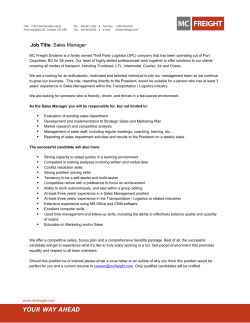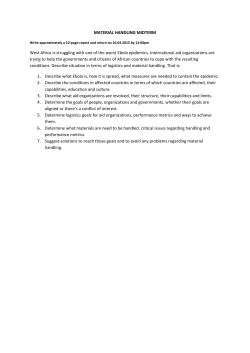
whitepaper
Optimized Transportation Routing By optimizing its network, a food manufacturer and distributor was able to reduce its annual transportation costs by 10%. By Michael Pedersen CASE STUDY Optimized Transportation Routing: A Case Study Leadership at Nissin Foods, a Gardena, CA-based prepared foods manufacturer, was tasked to materially reduce year-over-year transportation spend. The organization needed to implement a strategy to optimize its transportation network, yet it had no in-house team focused on network engineering or design. Enter Yusen Logistics’ Supply Chain Solutions Team. Yusen Logistics has a proven record of engineered solutions that enhance performance and drive out costly inefficiencies from its client’s supply chains. A well-defined approach to solutions engineering involves a clearly defined analytical approach with logical, sequential phases that produce consistent results. Analysis and Goal Setting Nissin Foods is a large scale manufacturer and distributor of convenient instant foods. It ships millions of cases of product over 12 million miles to almost 1,000 locations in the U.S. each year. Yusen Logistics’ first step in its network optimization process was to evaluate and standardize the data for Nissin Foods’ annual shipping volume to ensure that locations, quantities, distances and rates were properly interpreted during the analysis phases. Redundant information was removed and relevant data was standardized. Analysis of Nissin Foods’ product shipments Percentage of units shipped by mode Percentage of cost by mode <1% 8% <1% 56% TL LTL Rail Ocean 92% 42% <1% <1% YUSEN LOGISTICS | NISSIN FOODS CASE STUDY 2 Comparison of transportation modes Transport Mode Total LTL moves represented less than 10% of total volume shipped, but more than 40% of overall transportation costs. Ship Quantity Percent of total Shipment Weight Percent of total Truckload Less than truckload Rail Ocean 91.4% 8.0% 0.5% 0.1% 91.6% 7.9% 0.4% 0.1% Total 100% 100% Linehaul Cost Percent of total 56.2% 42.0% 1.0% 0.8% 100% Analysis for Nissin Foods revealed that the company had two U.S.-based production facilities, one on the East Coast in Middletown, PA, and another on the West Coast in Gardena, CA, serving the eastern and western U.S. respectively. When evaluating allocation of cargo across historical Less Than Truckload (LTL), Truckload (TL), Intermodal (IMDL) and rail modes, the total LTL moves represented less than 10% of total shipped volume, but more than 40% of total overall transportation cost. A goal-setting meeting was held with Nissin Foods to review the results of the analysis and ensure that goals were aligned. During the meeting, it was determined that the TL volume was being consistently optimized with regard to loaded volume and routing, but that LTL volume could provide significant opportunities for optimization through consolidation methodologies. As a result, they decided to focus specifically on reducing the LTL spend for the organization. Network modeling was undertaken by Yusen Logistics’ engineers to leverage Nissin Foods’ historical data and create a model of its distribution network including manufacturing sites, consolidation and distribution centers, cross docks, ports, ramps and final delivery locations. The company’s shipment volume was run through the model to provide an accurate representation of the current network and measures of time, cost and volume as products flow through the existing supply chain. Network distribution model YUSEN LOGISTICS | NISSIN FOODS CASE STUDY 3 Any number of scenarios can be modeled and analyzed so the best possible network design that yields the highest performance can be virtually evaluated. Creating ‘What If’ Scenarios Once the network model design is complete, Yusen Logistics’ engineers can create “what if” scenarios to measure the cost and service impacts of strategic changes to the network and accurately determine if those changes result in increased efficiencies at favorable costs. For example, the centers of customer demand can be measured to determine if distribution facilities are properly positioned. Could positioning distribution closer to customer demand reduce overall transportation cost? Would demand positioning result in more efficient service times to better respond to critical customer delivery requirements? Any number of scenarios can be modeled and analyzed so the best possible network design that yields the highest performance can be virtually evaluated. For Nissin Foods, it was determined that a large number of individual LTL shipments were traveling long distances from the existing distribution centers at a high unit cost. Yusen Logistics’ engineering team asked “what if” Nissin Foods built optimized, consolidated multi-order inbound full truckload shipments that would move consolidated shipments closer to customer demand and then utilize LTL crossdocks proximate to demand for final deconsolidation and shorthaul LTL delivery to the end customer. The network model allowed the engineers to identify areas of concentrated demand that would yield results. Hypothetical points added to the model Hypothetical distribution points were added to the model and the volume was run and measured to determine the cost, adding both the cost of the inbound consolidation runs and the LTL distribution to the final customer. The model was subjected to variations in weekly product flows, peaks and seasonality, in order to realistically test the new network for capacity and sustainability. Decisions were made regarding weekly flows and when consolidation or direct ship would yield the greatest benefit. The new modeling options were then measured against the baseline cost to determine the effect of the network change with regard to key metrics. YUSEN LOGISTICS | NISSIN FOODS CASE STUDY 4 Model finds LTL savings The initial program has yielded more than 10% savings in transportation costs. TransportProjected Mode Percentage Saved LTL with Kansas Cross Dock LTL with Illinois Cross Dock LTL with Kansas and Illinois Cross Dock 8% 8% 10% In Nissin Foods’ model, routing LTL cargo through demand points in Kansas and Illinois resulted in an almost 8% reduction in transportation cost, respectively, and more than 10% cost reduction when combined. The optimized volume, when annualized, would result in significant annual savings for just these two locations. Concentrations of demand density were then further modeled for additional consolidation opportunities, ensuring that the distribution would yield positive results prior to initiating any structural changes to the existing network. Implementation and Results Yusen Logistics’ operating divisions work hand-in-hand with its customers to ensure that the Implementation of any supply chain solution strategy is a truly cooperative effort that delivers the expected results. For Nissin Foods, Yusen Logistics’ Transportation Group’s Specialized Services Division was chosen to execute the consolidation and pool point distribution strategy developed by Yusen Logistics’ Supply Chain Team. The optimization systems uses modular design to sequence individual orders into optimized full truckloads and even multi-stop deliveries, capitalizing on equipment availability and efficient route design. The initial application of the program has yielded a 10% + savings in transportation costs. The end result is an efficient, transparent partnership that focuses on developing and delivering protracted results and ongoing competitive advantage for all stakeholders. Yusen Logistics’ load building system With Yusen Logistics’ load building software, operators use a modular system to combine LTL shipments into optimized truck loads. YUSEN LOGISTICS | NISSIN FOODS CASE STUDY 5 Continuous Improvement Even when the solution is in place, Yusen Logistics’ work does not stop. The Kaizen culture of continuous improvement means the company is never finished delivering results. Kaizen is rooted in continuous improvement and is a supporting pillar of Six Sigma methodology. Continuous improvement is recognized worldwide as a key component of an organization’s long-term competitive strategy. Kaizen is a way of thinking, a culture and in the DNA of Yusen Logistics. The modern supply chain is dynamic and ever changing. Supply chain performance should be subjected to routine health checkups to ensure that optimal performance is being achieved in the face of shifting demands and market trends. Yusen Logistics (Americas) has a long history of service and dedication to its customers. As a member of the NYK Group, the company draws upon more than 125 years of industry experience. Yusen Logistics provides end-to-end supply chain capability across a range of industry verticals that drive competitive advantage for today’s global marketplace. Let Yusen Logistics Supply Chain Solutions team design a solution for you —Michael Pedersen is Senior Analyst, Supply Chain Solutions, Yusen Logistics (Americas). Work with Yusen Logistics’ Supply Chain Solutions Team Yusen Logistics’ Supply Chain Solutions Teams develops and fosters strategic business relationships with our customers. We apply our analytical tools and structured methodology to uncover tangible value that will have a meaningful impact to our customers’ supply chain strategy and competitive performance. For every client, we follow these steps to ensure that your supply chain network challenges are met: YUSEN LOGISTICS | NISSIN FOODS CASE STUDY 6 About Yusen Logistics Yusen Logistics is a global logistics and transportation provider that delivers custom supply chain solutions through one of the largest air, ocean and land transportation networks. We have over 478 offices in 40 countries, with more than 19,000 employees at your service. Combining our services give you greater control and visibility over your supply chain. For information about our Supply Chain Solution Services, e-mail michael.pedersen@us.yusenlogistics.com or visit our website at www.us.yusen-logistics.com. YUSEN LOGISTICS | NISSIN FOODS CASE STUDY 7
© Copyright 2025









